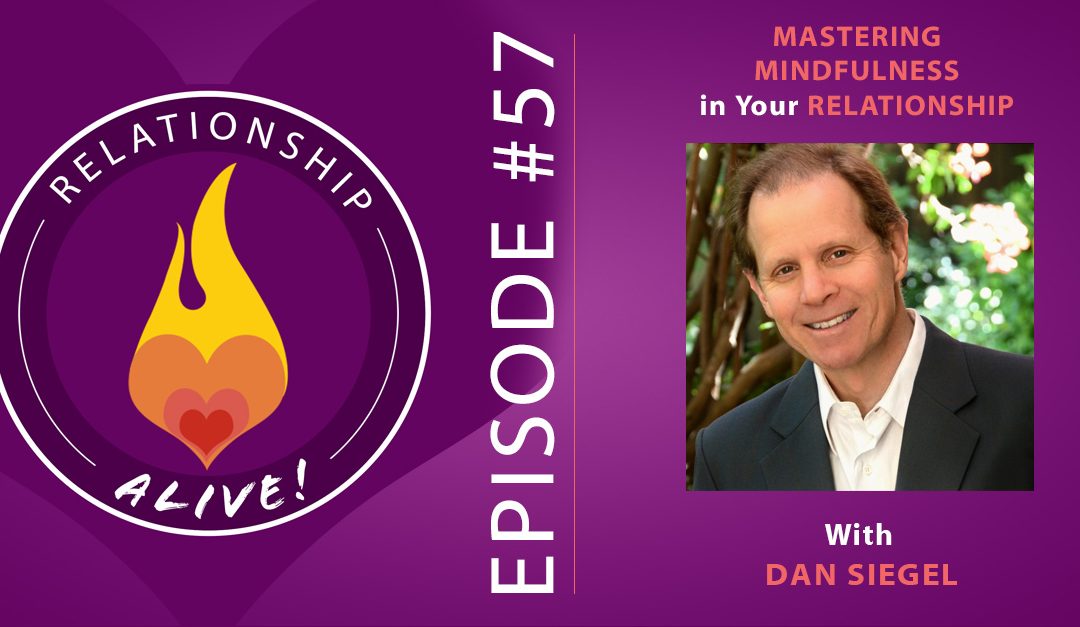How do you harness the power of your mind so that it’s working for you, not against you - especially when things get triggering with your partner? We now know that our minds are flexible, and that through neuroplasticity you can continue to develop and change throughout your whole life. In today’s episode, we are talking with Dr. Dan Siegel, one of the world’s leading experts on mindfulness and neuroplasticity, about you can apply mindfulness with your partner to develop deeper connection to each other, and to yourself. Come along for the ride, as we take an in-depth look at the relationship between your mind and body - and your partner’s mind and body!
Self- In today’s culture we have equated Self as an output of the mind, and the mind as some outcome of the brain. We have narrowed our definition of Self and separated it from a broader and more integrated wholeness. Invite in the possibility that your sense of SELF comes from the weaving together of many layers of your being, and is as expansive as it is tangible.
Integration: Integration is the basis for wellbeing. Integration is the unifying principle that various aspects of a system are honored for their differences, and then linked. Integration is at the core of healthy brain functioning, and healthy relationships. In an integrated state, the social engagement system of our brains is turned on and we are available for connection.
MWE: A healthy relationship is not about dropping your own sense of Self, it is about learning to honor the uniqueness and individuality of both partners and integrating the two into a new whole. It is about going from ME to MWE: a new WE created by the joining of your two Selves into a new entity.
Mindsight: Mindsight is our capacity to be aware of our own minds. It is our ability be aware of our habitual patterns and behaviors and move away from being on autopilot. Mindsight is the capacity to 1) have insight into yourself, 2) have empathy for other people, and 3) honor differences and promote integration. Mindsight is something that can be developed and learned, and must be in order for healthy relationships to form. Thanks to neuroplasticity, increasing mindsight can physiologically and neurologically change our brains- helping us shake off old or inherited patterning and allowing us to become more aware, available, and attuned individuals.
PART: This is an acronym that helps get to the core aspects of how you are or are not showing up in your relationships. What PART do you play in your life to bring more health and restoration to yourself and your relationship?
P: Presence- Presence is the ability of being in an open and receptive state that allows you to connect with whatever is arising inside of yourself. Once you can be present for yourself, you can learn to develop a deep acceptance of what may come up. As we learn to be with, and tend to, and remain aware of our own triggers, emotions, thoughts, and patterns, we then learn to caretake ourselves in ways that take pressure off of our partners and allow us to be more present with THEM!
A: Attunement- By learning to direct your focus of attention, as if it is a stream of energy you can point in various ways, you gain the ability to attune to both yourself and others. Asking questions is a wonderful way to refocus attention. Ask yourself: what meaning does this have for me? What is happening right now? What is happening beneath my/your behavior right now? This curiosity and looking for the underbelly of behavior allows you to gain access to the subjective world of attitudes, beliefs, stories, longings, dreams, insights, and other aspects that are often influencing behavior in the moment.
R: Resonance- If, and only if, you are present, open, and attuned, can you resonate with others. Resonating with others is the ability to allow someone else’s internal state to affect your own. It is the openness to being changed because of another. To be touched. To shift inside in response and attunement to another. Feeling felt by others, and willingly feeling with others is the beginning of becoming a MWE.
T: Trust- When presence, attunement, and resonance are achieved the social engagement system of our nervous system is engaged and turned out. Our brains are wired towards reactivity (flight, fight, freeze, disconnect, avoid, defense, etc.) however when we are in safe and true connection with others we become receptive. Our neurobiology is changed when we feel safe- our muscles relax, our heart rate lowers, and we enter into a ventral vagal state that allows for even more P and A and R. Trust is simultaneously a requirement and an outcome of being in connection with others.
Positive emotion comes from connection. Research (and experience) have shown that positivity resonance is possible whenever there is human connection, even if it is around being together through suffering or difficulty. The act and process of reaching out to another and connecting, no matter their state, changes the neurobiology of both of you and increases the level of integration. The higher the integration the higher the positivity resonance. This is true because as you reach out you provide relief for the sufferer (who felt alone before), and the sense of compassion and empathy is increased in both individuals, therefore forming a sense of MWE.
Converting implicit memories into narratives of growth and coherence: Very often our reactions in a given moment are more based on implicit memories (those that live in our subconscious) than they are to the present issues/content. We react to the now as if the past were the present, and this can cause confusion, hurt, and high tension in relationships and wreak havoc in our interactions. When we are unaware and unable to differentiate between present and past we react to triggers in one of four ways: fight, flight, freeze, or faint. To begin the process of bringing these patterns into awareness, attune to your own internal state and notice when you shift from a place of receptivity to one of reactivity. Notice the difference in your body, and become aware of the micro-shifts that help clue you into knowing you are beginning to go into defense/reactive mode. This process has a physiology to it- be it clenched jaw, tightened chest, shallow breathing, getting sweaty, higher pitched voice- begin to map these for yourself so that you can fine tune your self-awareness.
Something needs to be done. Nothing positive happens in relationships when we are reactive! That said, it is crucial to learn ways to move out of reactivity and back into receptivity before engaging in fixing/healing/processing. Once you have become skilled in attuning to your internal state of being and noticing when you shift into a reactive state, then it is critical to learn how to take care of yourself. This can be anything and everything from journal writing, to walking around the block, to sitting for a meditation, to calling a friend, to putting on some music and dancing, stretching, drinking a glass of cold water, etc. Whatever your go to self-care and de- escalation strategy is, you MUST first be aware that you need to take a break! This inner work allows you to get back into a state where you are available and open to receiving and being in connection.
Memory retrieval is a memory modifier. Once you are able to 1) notice that you are being triggered and 2) able to pause and get out of the reactive state, then you can begin to get curious. What past experiences- be it a single incident, or chronic long term patterns, are informing your reactions right now? Ask non-judgemental, open ended questions of yourself. Write. Process with others. Go to counseling. As you find core explicit memories, you then have the opportunity to bring them into awareness and label as ‘past’. The process of bringing memories into consciousness (memory retrieval) is in itself a form of modifying the memory. Identifying the old memories that have been informing your present reactions allows you to make connections, see links, and gain insight into why you respond the way you do. From here you can make meaning of madness, and meaning of memory. Your implicit memories become explicit, and what is automatic becomes autobiographical. You can begin to own your reactions in empowering ways, saying things like ‘There is a theme in me where I get very defensive when I have the feeling of being rejected because my father never thought I was good enough.” Themes that you may begin to identify could be: abandonment, feeling worthless, neglect, isolation, rejection, being invisible, being smothered, being given too much responsibility, being ignored, being abused, etc. As you shift the ways you relate to yourself and your past, you will find your relationships shift too!
SIFTing: Our brains are wired with a negativity bias- meaning we automatically scan and focus on negative aspects of an experience (this is due to survival wiring). That said, our brains are elastic and neuroplasticity allows us to change our brain by changing our focus and rewiring our circuitry. We can do this by taking the time to notice and savor positive experiences. SIFT is a practice and process of focusing the Sensations, Images, Feelings, and Thoughts associated with a positive experience. Try it! The next time you recognize a moment or experience for which you are grateful for, relieved by, appreciative of, or feeling good about, pause and flow through the SIFT process focusing for just long enough to soak in the various aspects of the experience. Neurons that fire together wire together, and therefore these small but frequent exercises begin to reshape our brains in a way that is organized around positivity, making us more receptive and less reactive.
The Wheel of Awareness: Imagine a wheel- hub at the center, spokes leading outwards towards the rim. Now imagine that the hub is the seat of your awareness. Your consciousness resides here- centered, central, calm, clear, open. From here you can send a spoke of attention around to the rim, upon which resides all we can be aware of: our five senses, the interior of our bodies, our mental activities, and our sense of interconnectedness. Through practicing the wheel of awareness meditation you can develop the ability to 1) differentiate between awareness of rim elements and awareness of hub elements, 2) recenter yourself in the hub as the source of your consciousness, and 3) redirect your focus of attention/spoke. All of this helps to build your capacity to be in that deep presence so essential to receptivity and attunement.
Remember: The more integrated you can become the more you are able to lean into challenges, and the more open you become to new possibilities!
Resources
Visit Dan Siegel’s website for more resources
Want to know more about the Wheel of Awareness? Check it out here!
Read Dan Siegel’s book Mindsight
Order your copy of Dan’s newest book Mind: A Journey to the Heart of Being Human which is set to be released October 18th, 2016.
https://www.neilsattin.com/mind Visit to download the show guide, or text “PASSION” to 33444 and follow the instructions to download the show guide to this episode with Dan Siegel.
Our Relationship Alive Community on Facebook
Amazing intro/outro music graciously provided courtesy of:
The Railsplitters - Check them Out


